Recent Articles
-
Christmas Sword Buying Guide 2025
Dec 03, 25 10:53 PM
Musashi Fast Cutter Katana Review
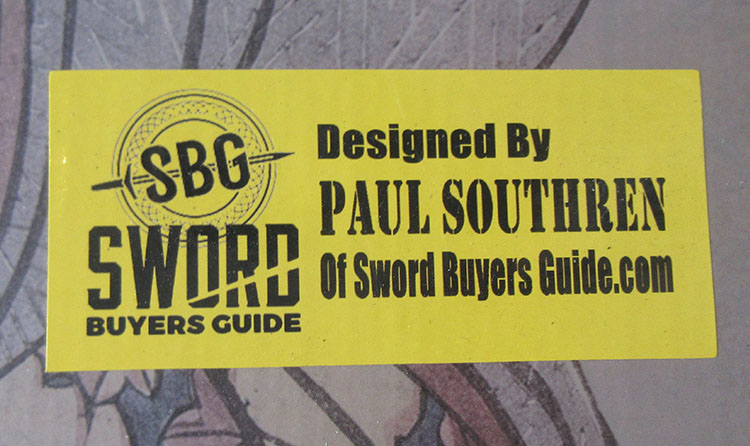
As the designer of the Musashi Fast Cutter Katana, I don't know how impartial I can be when it comes to writing a review..
Full disclosure: I designed this sword in consultation with the current owner of Musashi Swords - one of the premier manufacturers of bare bones and entry level Katana around - and WILL receive a small royalty commission for each sale of this blade that will be put to good use to keep SBG going and growing into the future.
However, as anyone who has followed SBG over the years will know - despite our affiliations with various sword makers, our credibility comes first. After all, if we don't 'tell it like it is, warts and all' people are going to buy it and be disappointed - and that's not good for anyone.
So in the spirit of SBG I will do my best to be as impartial as possible. Because while it IS a sword I am proud to put my name to, it didn't quite turn out exactly as I had designed..
Musashi Fast Cutter Review
Review by SBG Editor in Chief, Paul Southren
My goal when designing the Musashi Fast Cutter Katana was two fold. Firstly, I wanted to design a Katana that had features rarely seen on most production Katana, and secondly, I wanted it to be fast in the hand, made from the best possible materials and affordably priced.
So I spent some time thinking about what would make a nice, fast cutting sword - and decided that it had to have three main elements:
- A bo-hi/fuller, to lighten the blade and shift the balance slightly back towards the tsuka handle.
- A minimalist tsuba, to protect the hand but reduce the overall weight and give it a sleek appearance.
- And a differentially hardened blade for maximum sharpness and hardness to ensure it cuts with the best of them.
So with these elements in place, I spent some time going over Musashi's available fittings - provided the specs, and let the Musashi forge do it's thing until a familiar, long cardboard box arrived in the mail..

The Musashi Fast Cutter came double boxed, with a standard brown cardboard box over a branded inner box which states 'the Musashi Difference as':
- Official Weapon of the United States Kempo Team
- Silver and Bronze Medal winner in the weapons category at the WKC Championship
- Forged under the advisement of Head Master Ueno Kagenori Genki of Tenshinsho Jigen Ryu.
- Musashi Swords are rated 4 stars in Sword Buyers Guide.
- Recommended by editor of Katsujinken Sword Arts Journal Magazine.
- Recommended by Will Keith, the fat swordsman.
Not a bad pedigree.
Anyway, inside the sword itself was sitting in a standard cotton sword bag, protected by strategically placed Styrofoam collars.

Time to see how it looks...
The Fittings
First up, the Musashi Fast Cutter Katanas saya.
Now the saya is nothing special - nor was it designed to be, as the fancier the saya, the more expensive the end product - and that would not gel well with my goal of making this sword AFFORDABLE.

Indeed, this saya could belong to any entry level production sword - basic black lacquer, shoelacey sageo cord and pretty lightweight overall.
It did fit well (actually, it's pretty much perfect), which is always hit and miss, as saya can and often do expand or contract slightly depending on atmospheric conditions, temperature, and barometric pressure (after all, it is IS made of wood). So while mine was nice and snug, your mileage may vary.
It was crafted fairly well however, below you can see the 'koiguchi' or mouth of the sheathe which is nicely shaped and evenly finished.
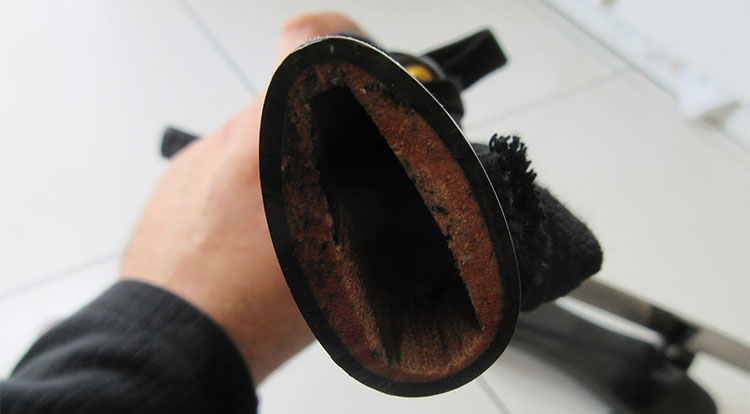
Next up, the tsuka (handle).

First off, the tsuka was nice and tight - no wiggles, rattling or any looseness whatsoever. And it did have a nice ergonomic shape to it rather than the typical 'boxy' shape you often see on entry level Katana.
I actually designed it to be black on black, but Musashi decided to go for a more traditional black cotton on white rayskin motif - and in all honesty, it worked out pretty well.
The cotton ito is comfortable in the hand and nice and tight - reinforced partially by a much longer and more robust menuki (handle ornament) which, in fitting with the bamboo theme, depicts the nodes of a length of thick giant bamboo.

The bamboo motif also appears on the fittings of the fuchi and kashira - the two end caps of the handle..
Here is the bamboo design of the brass Kashira (butt cap) which, I should add, is secured nicely with no movement or wiggle.
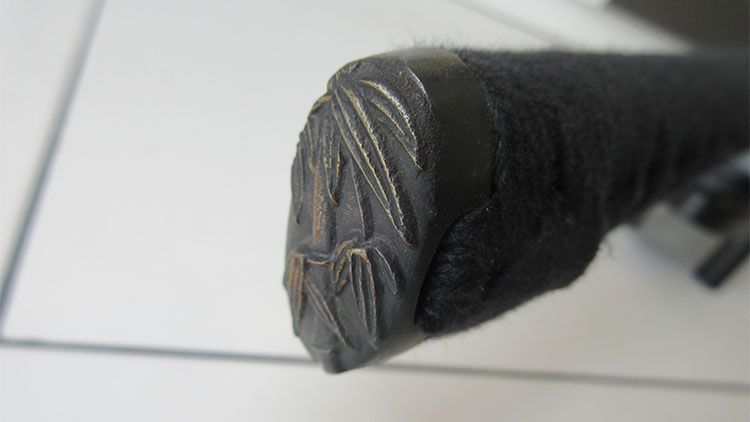
And towards the blade, complimented by a bamboo themed 'fuchi'.

Here you also get a first glimpse of the so called 'Hamidashi' tsuba - a small brass tsuba that is usually seen on Wakizashi and Tanto, but historically was sometimes used on full length Katana.
And there were two reasons why I selected a hamidashi tsuba for the Musashi Fast Cutter - one, as I already mentioned, was to keep the swords overall weight down.
But the second reason was purely aesthetic - personally I love the serpentine lines of a well executed hamidashi. And there is enough protection there to prevent the hand slipping onto the blade, which is not present on Aikuchi Katana or Shirasaya, both of which have no tsuba at all.
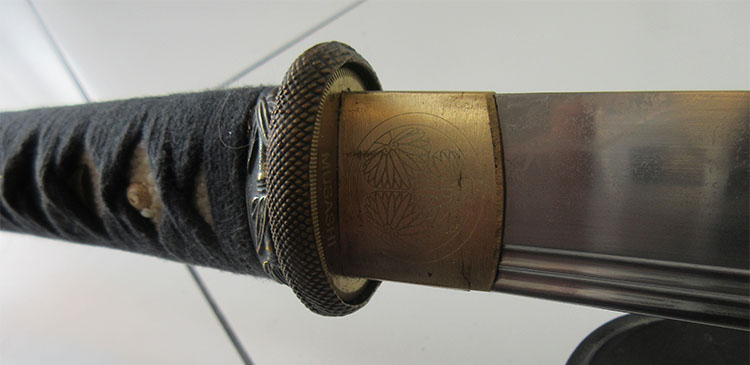
Above you can see the tsuba and habaki from a different angle. Note the chrysanthemum theme on the habaki, which is very nicely mated with the blade.
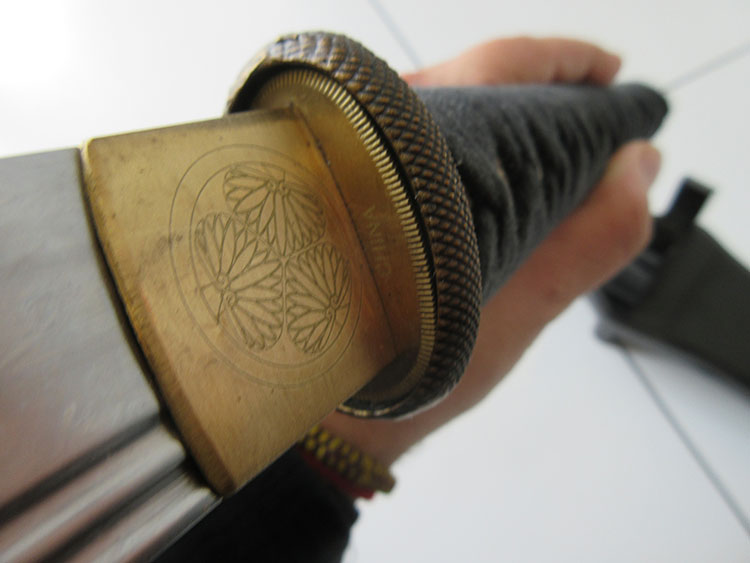
And since now you have had a peak at the distinctive double bo-hi, might as well start talking about the blade..
The Blade
One of the first things that jumps out at you when you first see the Musashi Fast Cutter is of course the double bo-hi/fuller.

It is debatable if there is any real difference between a single and double bo-hi, as a standard bo-hi is much wider and deeper than a single line of the double hi - though it could be argued that as it is not as deep, it reduces minor losses in durability from a standard bo-hi and reinforces and stiffens the blade.
The downside is that the double hi does not catch the wind quite as well as a single deep bo-hi, so the blade is almost silent as it cuts the air. But as this is a cutting sword, not a training sword, I think the trade off - however minor it may be - is worth it.
Now the blade itself is made from 1060 carbon steel - a hard wearing, durable steel typically used on monotempered blades - but the Musashi Fast Cutter is not monotempered - the hamon is real and a result of clay tempering.
And like most hamon, easier to see in person as it shifts in and out of view depending on the relative position of a light source, rather hard to photograph.
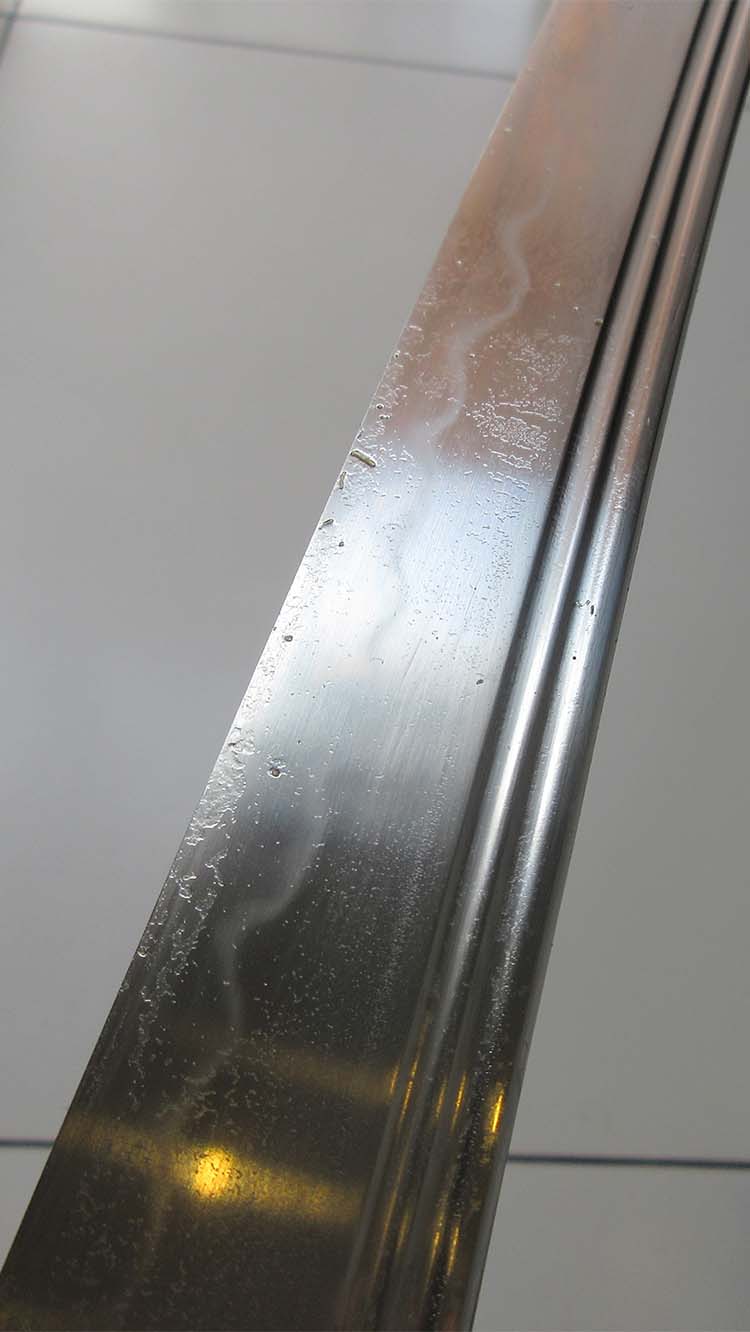 Blade as it comes out of the box, with a light layer of protective oil
Blade as it comes out of the box, with a light layer of protective oil And after a quick wipe down
And after a quick wipe downOverall, the hamon was nicely executed - at no point does it come close to or wander off the edge of the blade, and it continues all the way to the 'boshi' at the tip (kissaki) which is counter-polished, but not rough or ugly as many kissaki are at this kind of price point.

Handling
Handling is always a subjective thing - but some raw stats, the Musashi Fast Cutter weighs 2lbs 10oz and has a point of balance around 5" from the tsuba.
But how does it actually feel in the hand?
What I can tell you is that, despite having a thick and sturdy spine and a fair amount of hira-niku (meat to the blade) the Musashi Fast Cutter feels surprisingly lightweight. Indeed, Will Keith - the aforementioned fat swordsman mentioned on the box, says that out of all his swords this one is the lightest, even though it turned out to be a fairly hefty piece..
That said, I actually wanted it to have a thinner and more narrow blade to take advantage of the slightly shorter length (27", measured from the back notch on the habaki, or 28" if you measure from the tsuba, which a lot of sword companies do, even though it is not correct).
Personally, I find it to be just a little too blade heavy - as the thicker blade negates a lot of the careful balancing done with the fittings and the double bo-hi.
So at the end of the day, despite being quite light weight - the balance is a little more neutral than what I had wanted - if you hold it straight out in front of you with the edge of the blade pointing downwards, you can feel that the balance is more towards the tip than the butt cap, which is good for powercutting, but makes it hard to suddenly change direction.
In one sense, I feel that it failed at my intended goal - to create a sword that is extremely fast and responsive, and able to turn and change the direction of a cut on a dime. But in other sense, you can still call it a 'fast cutter' because the initial cut is extremely fast and effortless - and with the extra thick 1060 carbon steel spine, should be a lot more durable overall than earlier differentially hardened Katana by Musashi such as the 'other' bamboo, which is made from 1045 carbon steel (a much softer, weaker steel).
Only one way to know for sure. Though mid test, I found out I was pushing it a lot harder than I thought I was..
Testing
Probably one of the most popular targets for backyard cutters is the humble water filled P.E.T. bottle. When filled with water, the surface tension is strong enough to deflect a .22 caliber bullet fired at it - but with good edge alignment, a Katana can cut through it like it is not even there..
And that was the case with the light cutter - despite being in a slightly awkward position, cutting left to right instead of right to left as I am used to, it sailed through any water bottles I put in front of it as if it was cutting the air.

Easy enough, and no real surprise, as the blade was very keenly honed along the entire length. But where I had seen another entry level Musashi Katana fail was on bamboo (ironically enough, it was called the bamboo - but the blade chipped when I cut with it - click here to read the review if you are interested).
So the ultimate test to ensure it was at least a step or two above the bare bones Musashi Bamboo was by testing it on some bamboo - which I happened to have conveniently growing in pots in my garden..

Now I had some idea that this was not your usual run of the mill river-cane bamboo that had defeated the previous Musashi sword. This stuff felt much thicker and heavier - and I was surprised by how much hacking it took to cut off a length for testing..
The shoe had not yet dropped even as I took it inside and swiped the Musashi Fast Cutter single handedly into the bamboo, biting about halfway through and deep into the node (the hardest part of bamboo).
Indeed, it was only after I completed another couple of swipes - and cut the bamboo in half, that I realized why it was so difficult to cut. For unlike standard bamboo. this bamboo variant was almost solid the whole way through, while most shoots of bamboo are thinned walled and mostly hollow..!

It turned out my test was more akin to cutting a wooden broom handle than a length of bamboo!
But the verdict was in - this sword could cut and it could cut well. And moreover, a quick wipe down with a cloth and some WD-40 showed zero edge damage - not even a mark.
It was sharp. It was tough. And it was traditional.
All in all, a nice combination - and perhaps not possible if it had been made to by original specs..
Conclusion and Second Opinion Review
So apart from the designed black on black handle and thinner blade, the Musashi Fast Cutter turned out cosmetically much like I was hoping it would. The critical features were there: double bo-hi, differentially hardened blade with real hamon and hamidashi tsuba - all in a traditional bamboo theme.
And there was no mistaking its ability to hold and keep an edge, chewing up that bamboo was proof enough of the Musashi Fast Cutter and its edge retention ability.
And yes, it was lightweight - though not quite balanced the way I was expecting due to the thicker blade. But while Musashi took this feedback seriously and are planning on creating a second version exactly to my original specs, I don't think that this sword should be phased out but rather that the second sword should be an entirely new design concept - leaving this Musashi Fast Cutter as it is.
So in the meantime, in case my bias has crept in unintentionally, here is a second opinion review by the 'fat swordsman' Will Keith.
I am guessing that I am, if anything, being a bit harsh on the sword after hearing what Keith had to say about it..
PROS
- Lightweight, fast and neutral in the hand
- Tight fittings, really nicely assembled and solid construction
- Natural hamon with a keen, sharp edge
- Sleek and attractive, unique design
- Great pricing (under $200)
CONS
- Not quite as responsive as I envisioned with the original design
- Basic saya with shoelacey sageo cord (cost cutting measure
Finally, not sure if it can be officially considered a 'con' but the Musashi Fast Cutter is a limited edition sword and availability can be a bit of an issue. If it is sold out, there is no guarantee that it will be coming back again anytime soon - so if you like it, you definitely will want to keep an eye out for it and see if it makes the 'regular rounds' of Musashi's line up.
WHERE TO BUY
The best place currently to pick up the Musashi Fast Cutter is here at Amazon.com where it goes out the door for just $199.99 which is great value for a differentially hardened blade of this caliber.
As the current sword is a limited edition model, if you see them listed as available, you had best jump on them quick.
I hope this review of the Musashi Fast Cutter has been helpful. To return to Affordable Replicas of Japanese Swords from Musashi Fast Cutter Katana Review, click here

Buying Swords Online Can Be DANGEROUS!
Find the Best Swords in the:
Popular & Recommended ARTICLES

The ONLY true free online magazine for sword enthusiasts. Delivered once a month on the 1st day of the month, no filler and no BS, just the latest sword news & info delivered straight to your inbox.













